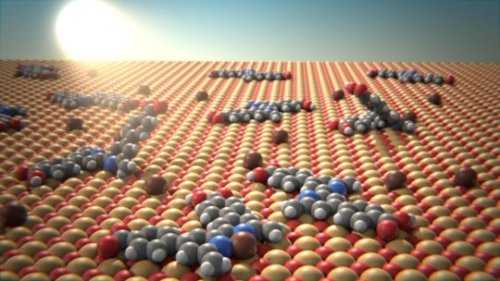#nickel oxide
Metal leads to the desired configuration
Scientists at the University of Basel have found a way to change the spatial arrangement of bipyridine molecules on a surface. These potential components of dye-sensitized solar cells form complexes with metals and thereby alter their chemical conformation. The results of this interdisciplinary collaboration between chemists and physicists from Basel were recently published in the scientific journal ACS Omega.
Dye-sensitized solar cells have been considered a sustainable alternative to conventional solar cells for many years, even if their energy yield is not yet fully satisfactory. The efficiency can be increased with the use of tandem solar cells, where the dye-sensitized solar cells are stacked on top of each other.
The way in which the dye, which absorbs sunlight, is anchored to the semiconductor plays a crucial role in the effectiveness of these solar cells. However, the anchoring of the dyes on nickel oxide surfaces – which are particularly suitable for tandem dye-sensitized cells – is not yet sufficiently understood.
Post link
Scientists found excitons in nickel oxide for the first time
Russian scientists from Ural Federal University (UrFU), together with their colleagues from Institute of Metal Physics of the Ural Department of Russian Academy of Sciences, have studied fundamental characteristics of nickel oxide nanocrystals and found excitons on the light absorption edge for the first time. An exciton is an electron-hole pair bound with electrostatic coupling that migrates in a crystal and transmits energy within it. The presence of an exciton in this area allows for detailed research of edge parameters in permitted energy bands. This may be useful for the development of next-generation optoelectronic devices. The results of the study were published in Physica B: Physics of Condensed Matterjournal.
Liquids and (under certain circumstances) gases are divided into conductors and dielectrics. The former conduct electricity, and the latter, respectively, do not. Semiconductors fall between these two categories—conductivity occurs due to the movement of charged electrons and holes within the crystal. They are found in systems with impurities that can either release or receive electrons, as well as after irradiation with high-energy light.
“In the physics of semiconductors, there is a notion of fundamental adsorption edge that indicated the edge-level energy of light adsorption. It corresponds to the energy gap—the area of energies an electron has to pass in the course of movement under the influence of light from the valence band (where it is usually located) to the conductivity band. A positively charged empty space that occurs at this place is called a hole. Its electrostatic (Coulombic) interaction with the electron in the conduction band causes the formation of an electron-hole pair, or and exciton. In the optic spectrum it can be seen as a narrow line a little below the fundamental adsorption edge. Notably, an exciton does not participate in electrical conductivity, but transfers the absorbed energy,” says Anatoly Zatsepin, a co-author of the article, and the head of a scientific lab at UrFU.
Post link


